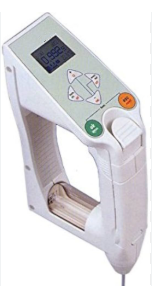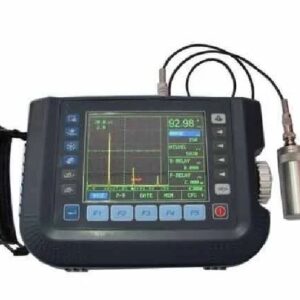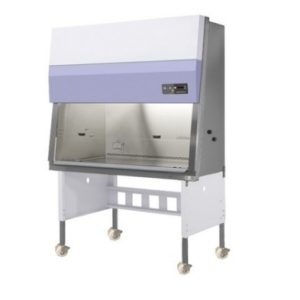REFRIGERATED CENTRIFUGE
MAKE DINESH SCIENTIFIC
DESCRIPTION
With the use of centrifugal force, materials with varying densities can be separated in a sophisticated laboratory device called a chilled centrifuge. It works on the idea that the denser particles in a sample travel outward and form different layers when it is spun rapidly. The following is a thorough explanation of a chilled centrifuge:
A sophisticated laboratory tool called a chilled centrifuge is used to separate particles according to their density from a liquid mixture. Centrifugal force is utilized by this apparatus to quickly spin samples in a temperature-controlled setting, usually between sub-ambient and room temperature.
FEATURES:
- Benchtop Refrigerated Centrifuge:
- Robust C.R.C. structure with powder-coated finish
- A centrifugal bowl made of stainless steel for added protection and simple cleaning.
- Equipped with an electronic drive and a well-balanced brushless motor.
- 20 characters in 4 lines. LCD display for rpm, CF, set and run times, and set times
- There is an automated dynamic brake and an imbalance detector.
MAIN COMPONENTS:
- ROTOR: The sample tubes or containers are held in place by the centrifuge’s rotor. It creates centrifugal force by spinning quickly.
- MOTOR: The rotor is driven by a strong motor, which enables high rotation rates
- CONTROL PANEL: Users can adjust centrifuge process parameters like speed, temperature, and duration via the control panel.
REFRIGERATION SYSTEM:
- This feature separates a conventional centrifuge from a chilled one. It has a cooling system that keeps the centrifugation temperature low, which is essential for protecting the integrity of samples that are sensitive to temperature changes.
APPLICATIONS:
- CELL SEPARATION: Cells are divided according to density in biological research.
- PROTEIN PURIFICATION: vital for separating and purifying proteins from complicated mixtures in biological investigations.
- DNA AND RNA EXTRACTION: helps to separate nucleic acids from biological materials more easily.
- CLINICAL DIAGNOSTICS: utilized in clinical labs for a range of diagnostic procedures, including the separation of blood components.
TEMPERATURE CONTROL:
- Depending on the model, the refrigeration system can normally regulate the temperature between below ambient and below zero.
SAFETY FEATURES:
- LID LOCKING MECHANISM: Makes sure the centrifuge lid stays firmly closed while it is in use.
- AUTOMATIC IMBALANCE DETECTION: In the event of an imbalance, stops the centrifuge to protect the samples and the device.
CAPACITY AND SPEED:
- SAMPLE CAPACITY: To handle a variety of sample sizes and kinds, refrigerated centrifuges are available in a range of sizes and rotor designs.
USER INTERFACE:
- Digital Display: For convenient monitoring of the settings, remaining time, and speed, the control panel usually has a digital display. In conclusion, a refrigerated centrifuge is a multipurpose laboratory instrument that combines temperature control and centrifugation principles, allowing scientists to precisely separate and analyze samples, particularly when working with materials that are sensitive to temperature.
ROTORS
| Rotor Type | Rotor Capacity | Speed on Rotor (r.p.m.) | Rotor |
| Swing-Out Rotor | 2 x 3 ml | 4500 | |
| Fixed angle rotor | 6 x 85 ml | 13500 | |
| Fixed angle rotor | 20 x 10 ml | 12000 |
TECHNICAL DETAILS:
| MODEL | DS-RC-SR-With-1-Rotor |
| Refrigeration System | CFC free, includes Pre-cooling of rotors facility |
| Type | Refrigerated table top universal centrifuge |
| Temperature Range | Selectable range from -20°C to 40°C |
| Control | Microprocessor controlled with touch-operation mode/system |
| Display | LCD for all pre-set & actual parameters (RPM/RCF, Time & Temp.) |
| Maximum Speed | 18,000 rpm |
| Relative Centrifugal Force (RCF) | 23,500 x g |
| Acceleration/Deceleration | 10 acceleration and 10 deceleration |
| Volume | 4 x 200-250 ml |
| Running Time Pre-selection | 10 sec to 99 h 59 min or Continuous |
| Noise Level | 63 dBA |
| Speed Selection | Both RPM & RCF |
| Rotor Capacity | Fixed-Angle-Rotor for 20 x 10 ml tubes |
| Maximum Speed | 12,000 rpm |
| Relative Centrifugal Force (RCF) | 15,700 x g |
| Motor Drive | Maintenance-free, without carbon brush |
| Chamber Material | Corrosion-resistant stainless steel |
| Lid Mechanism | Lid lock with a motor for effortless opening and shutting. |
| Rotor Identification | Automatic identification with over-speed protection |
| Imbalance Detection | Active Imbalance Identification system |
| Program Memory | 99 programs with permanent indication for actual and preset values |
| Self-Diagnostic System | Available for error detection |
| Quick-Key for Short Runs | Available |
| ROTORS & ACCESSORIES | |
| Swing-Out Rotor | Metallic swing-out rotor for 2 x 3 microtitre plates |
| Swing-Out Rotor Speed | 4,500 rpm |
| Swing-Out Rotor RCF | 2,710 x g |
| Fixed-Angle Rotor | Metallic fixed-angle rotor for 6 x 85 ml tubes |
| Fixed-Angle Rotor Speed | 13,500 rpm |
| Fixed-Angle Rotor RCF | 20,980 x g |
| Adaptors Included | For 50 ml conical tubes and 15 ml conical tubes |
| Rotor and Adaptors | Autoclavable |
| Voltage Stabilizer | Included with the offer |














Reviews
There are no reviews yet.